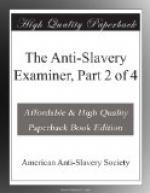The superintendent next took us to the solitary cells. They were dirty, and badly ventilated, and unfit to keep beasts in. On opening the doors, such a stench rushed forth, that we could not remain. There was a poor woman in one of them, who appeared, as the light of day and the fresh air burst in upon her, like a despairing maniac.
We went through the other buildings, all of which were old and dirty, nay, worse, filthy in the extreme. The whole establishment was a disgrace to the island. The prisoners were poorly clad, and had the appearance of harsh usage. Our suspicions of ill treatment were strengthened by noticing a large whip in the treadmill, and sundry iron collars and handcuffs hanging about in the several rooms through which we passed.
The number of inmates in this house at our visit, was forty-eight—eighteen of whom were females. Twenty of these were in the treadmill and in solitary confinement—the remainder were working on the public road at a little distance—many of them in irons—iron collars about their necks, and chains passing between, connecting them together two and two.
CHAPTER II.
TOUR TO THE COUNTRY.
Wishing to accomplish the most that our limited time would allow; we separated at Kingston;—the one taking a northwesterly route among the mountainous coffee districts of Port Royal and St. Andrews, and the other going into the parish of St. Thomas in the East.
St. Thomas in the East is said to present the apprenticeship in its most favorable aspects. There is probably no other parish in the island which includes so many fine estates, or has so many liberal-minded planters.[A] A day’s easy drive from Kingston, brought us to Morant Bay, where we spent two days, and called on several influential gentlemen, besides visiting the neighboring estate of Belvidere. One gentleman whom we met was Thomas Thomson, Esq., the senior local magistrate of the Parish, next in civil influence to the Custos. His standing may be inferred from the circumstance, (not trifling in Jamaica,) that the Governor, during his tour of the island, spent a night at his house. We breakfasted with Mr. Thomson, and at that time, and subsequently, he showed the utmost readiness in furnishing us with information. He is a Scotchman, has been in the island for thirty-eight years, and has served as a local magistrate for thirty-four. Until very lately, he has been a proprietor of estates; he informed us that he had sold out, but did not mention the reasons. We strongly suspected, from the drift of his conversation, that he sold about the time of abolition, through alarm for the consequences. We early discovered that he was one of the old school tyrants, hostile to the change which had taken place, and dreadfully alarmed in view of that which was yet to come. Although full of the prejudices of an old slaveholder, yet we found him a man of strong




